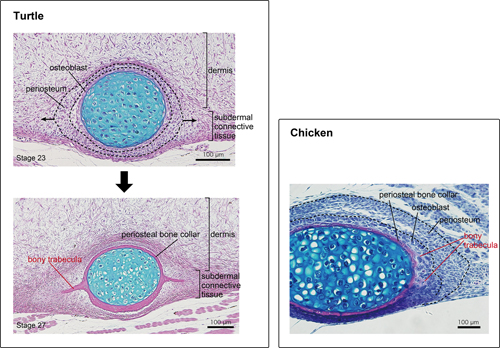| RIKEN Center for Developmental Biology (CDB) 2-2-3 Minatojima minamimachi, Chuo-ku, Kobe 650-0047, Japan |
July 18, 2013 –Exoskeletons are widely associated with invertebrates, typically envisioned as the chitinous armor of a beetle or crustacean. But vertebrates have exoskeletal elements too. Our own cranium, which lacks an overlying layer of muscle, is the exo- exception to our predominantly interior skeletal system. A number of mammals have also developed more extensive protective outer coats, but these vary dramatically in their composition – an armadillo’s scutes are completely different, for example, from a turtle’s carapace. While the armadillo’s scales are exoskeletal in origin, and the animal maintains internal ribs as in other vertebrates, only in the turtle does the endoskeleton make its way to the body exterior. Students of turtle evolution and development, however, have long debated whether there might not be some exoskeletal contribution to the formation of the carapace. Tatsuya Hirasawa and colleagues from the Laboratory for Evolutionary Morphology (Shigeru Kuratani, Group Director) have now found new evidence that may help put that argument to rest, through analyses of anatomical and paleontological data that squarely trace the origins of the carapace to exteriorized ribs of endoskeletal origin. Published in Nature Communications, this work adds compelling new evidence to support the theory that the turtle’s shell grows out from the inside.
Our skeletons evolved through a process of territorial give and take, with some elements advancing while other gave ground. By studying how such movements differ in embryos of various species, biologists have gained insights into the mutability of fundamentally conserved body plans. For the past two centuries, however, the turtle has remained something of a conundrum. While some hold that the carapace represents a fusion of endo- and exoskeletal elements (as the result of signaling by endoskeletal elements, i.e., ribs, that have shifted into the dermis, triggering the formation of exoskeletal tissue), others view it as a purely endoskeletal structure that nonetheless finds its way outside. To find an answer to this age-old question, Hirasawa analyzed the dorsal carapace of the Chinese soft-shelled turtle in close detail. The formation of this carapace begins with dorsal positioning of ribs and intercostal muscle primordia, after which the muscle element is gradually lost, leaving the periosteum of rib to expand laterally and serve as a scaffold that is subsequently filled in by bony trabecula. These bony elements later invade the intercostal spaces to form a complete carapace entirely as the endoskeleton. The group next compared the formation of the turtle carapace with that of ribs in a bird (chicken) and the bony dermal plates (osteoderm) of the alligator. While the carapace and avian ribs followed broadly comparable developmental sequences, the formation of the osteoderm differed dramatically, as it apparently involves epithelial-mesenchymal interactions within the dermis, further cementing the argument for an endoskeletal origin of the carapace. The paleontological record also holds clues to carapace evolution. Odontochelys, an ancient ancestoral turtle, had bony plate-like outgrowth derived from ribs, although it lacked a fully-closed carapace. Most vertebrates have movable joints between ribs and vertebrae, which facilitate respiration, so the rigidity of these bones in both Odontochelys and modern turtles is a remarkable feature. More recently unearthed intermediate fossils also underscore the evolution from axial endoskeleton to rigid shell. Examining the collection at the Institute of Vertebrate Paleontology and Paleoanthropology (IVPP) in the Chinese Academy of Sciences (CAS), Hirasawa identified a marine reptile, Sinosaurosphargis yunguiensis, which shows anatomical similarities with both Odontochelys and turtles that suggest the growth of an immovable shell within the subdermal tissue otherwise typically occupied by intercostal muscle. “We usually think of the turtle’s carapace as a form of protection, but it may have first emerged as an aid to swimming – a kind of surfboard if you like – that only latterly became hardened,” says Kuratani. “The study of unusual adaptations such as the turtle shell can teach us not only about the great diversity of the animal world, but the evolutionary programs that led to our own body plans as well.” |
|||||
|
|||||
|
|||||
 |
| Copyright (C) CENTER FOR DEVELOPMENTAL BIOLOGY All rights reserved. |
